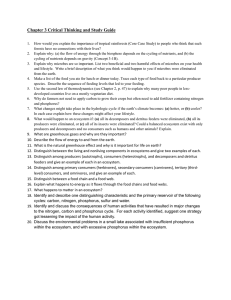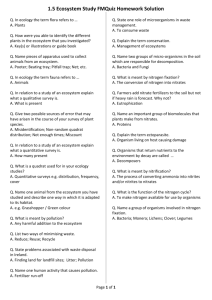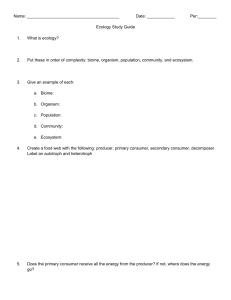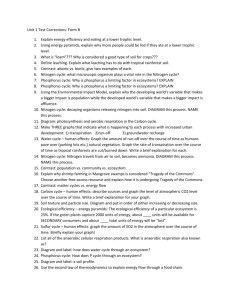Study Guide Chapter 3
advertisement
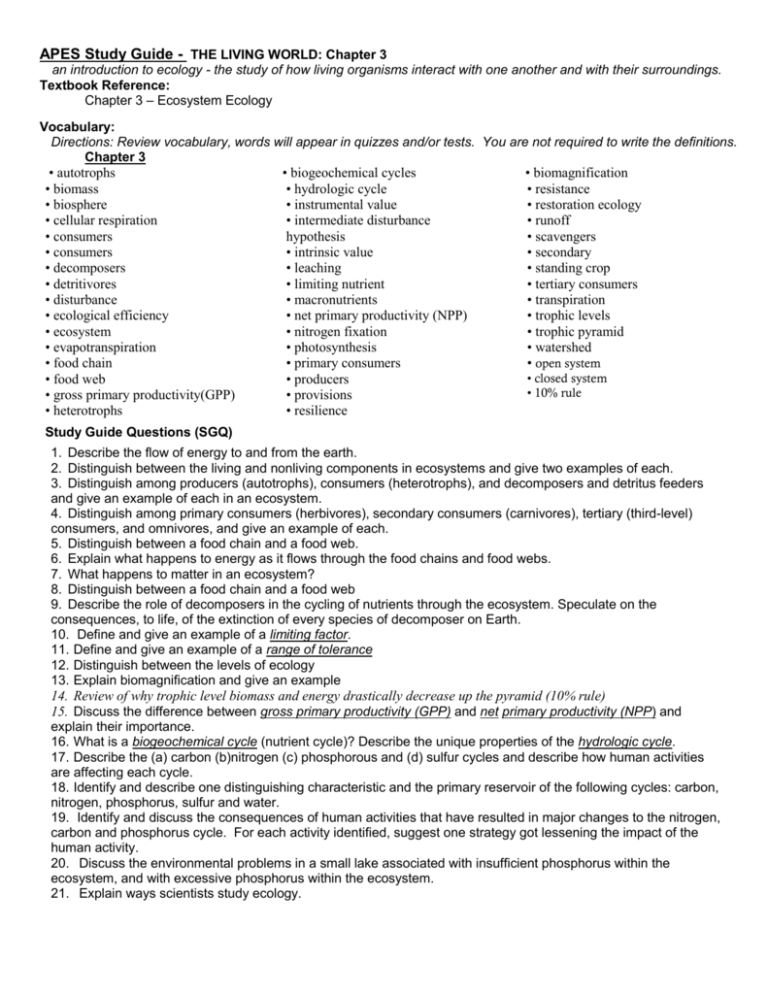
APES Study Guide - THE LIVING WORLD: Chapter 3 an introduction to ecology - the study of how living organisms interact with one another and with their surroundings. Textbook Reference: Chapter 3 – Ecosystem Ecology Vocabulary: Directions: Review vocabulary, words will appear in quizzes and/or tests. You are not required to write the definitions. Chapter 3 • autotrophs • biogeochemical cycles • biomagnification • biomass • hydrologic cycle • resistance • biosphere • instrumental value • restoration ecology • cellular respiration • intermediate disturbance • runoff • consumers hypothesis • scavengers • consumers • intrinsic value • secondary • decomposers • leaching • standing crop • detritivores • limiting nutrient • tertiary consumers • disturbance • macronutrients • transpiration • ecological efficiency • net primary productivity (NPP) • trophic levels • ecosystem • nitrogen fixation • trophic pyramid • evapotranspiration • photosynthesis • watershed • food chain • primary consumers • open system • closed system • food web • producers • 10% rule • gross primary productivity(GPP) • provisions • heterotrophs • resilience Study Guide Questions (SGQ) 1. Describe the flow of energy to and from the earth. 2. Distinguish between the living and nonliving components in ecosystems and give two examples of each. 3. Distinguish among producers (autotrophs), consumers (heterotrophs), and decomposers and detritus feeders and give an example of each in an ecosystem. 4. Distinguish among primary consumers (herbivores), secondary consumers (carnivores), tertiary (third-level) consumers, and omnivores, and give an example of each. 5. Distinguish between a food chain and a food web. 6. Explain what happens to energy as it flows through the food chains and food webs. 7. What happens to matter in an ecosystem? 8. Distinguish between a food chain and a food web 9. Describe the role of decomposers in the cycling of nutrients through the ecosystem. Speculate on the consequences, to life, of the extinction of every species of decomposer on Earth. 10. Define and give an example of a limiting factor. 11. Define and give an example of a range of tolerance 12. Distinguish between the levels of ecology 13. Explain biomagnification and give an example 14. Review of why trophic level biomass and energy drastically decrease up the pyramid (10% rule) 15. Discuss the difference between gross primary productivity (GPP) and net primary productivity (NPP) and explain their importance. 16. What is a biogeochemical cycle (nutrient cycle)? Describe the unique properties of the hydrologic cycle. 17. Describe the (a) carbon (b)nitrogen (c) phosphorous and (d) sulfur cycles and describe how human activities are affecting each cycle. 18. Identify and describe one distinguishing characteristic and the primary reservoir of the following cycles: carbon, nitrogen, phosphorus, sulfur and water. 19. Identify and discuss the consequences of human activities that have resulted in major changes to the nitrogen, carbon and phosphorus cycle. For each activity identified, suggest one strategy got lessening the impact of the human activity. 20. Discuss the environmental problems in a small lake associated with insufficient phosphorus within the ecosystem, and with excessive phosphorus within the ecosystem. 21. Explain ways scientists study ecology.
